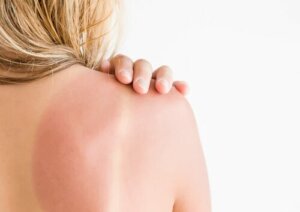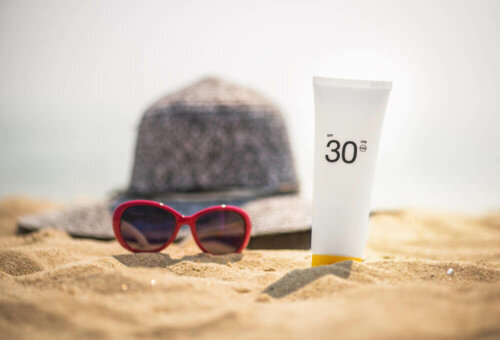Solar Erythema: Recommendations and Care


Written and verified by the doctor Leonardo Biolatto
Solar erythema is the typical sunburn that you suffer when you’re subjected to ultraviolet radiation for a long time. In general, the most intense symptoms appear in the first 24 hours and then begin to decline.
What is known as solar erythema is a set of conditions with different severity. There are slight lesions, with only a peeling of the outer layer of the epidermis. However, other times, the burn sheds a patch of skin and blisters. In either situation, the affected area becomes red from blood congestion. There isn’t always inflammation, but the flow of fluids in the tissues can increase in volume.
As we mentioned, this solar erythema comes from the sun’s ultraviolet rays. Although there are different wavelengths in the sun’s rays, the radiation that most affects the skin are UVB and UVA.
UVA radiation is very penetrating and can reach the dermis, which is below the epidermis. The negative effects of this type of radiation manifest themselves in the long term. It accelerates cell aging and favors the development of skin cancer.
On the other hand, UVB radiation is the direct cause of solar erythema or sunburn. The skin tans and burns due to this radiation. It’s also capable of changing cells and making them cancerous. Therefore, both radiations are a cancer risk factor.
Risk groups for solar erythema
Anyone can suffer from solar erythema if you expose yourself too much to the sun’s radiation at times when the sun is stronger and without protection. In any case, certain population groups are more prone to these burns. Among them are the following:
- Those who have to work in outdoor environments around noon.
- People with a very light complexion.
- Those who carry out water sports or mountain sports, since the reflection off the water and snow is capable of burning with the same intensity as direct light.
- Inhabitants of the tropics, where the direction of the sun is more perpendicular to the earth and the radiation schedule is longer.
- Patients taking certain antibiotics, such as doxycycline.
- Chronic patients with autoimmune conditions with dermal involvement, such as lupus.

Keep reading: The Harmful Effects of the Sun on Your Skin
What to do if you have solar erythema
Once you have solar erythema, you should take measures to alleviate the injury. You usually don’t need to visit the doctor in these cases. However, if you have any doubts about the severity or evolution of the burn, we recommend you consult your doctor.
If you know that you were very exposed to the sun and that the erythema is certain to appear, you should shower with cold water when you get home. You can also place cold objects on the affected skin to begin to control the inflammation that will appear.
You should wear loose-fitting clothing while the erythema lasts. Rubbing from shirts and pants hurts, in addition to promoting flaking, which can be dangerous if there are blisters.
In case you have fluid-filled blisters, it’s best not to pop them. You have to let them evolve without too much intervention. You can rub creams with pain relievers and coolants can around it, as well as the covering them with a sterile bandage so that they don’t become infected.
Regarding medication, the article “Approach to the treatment of skin aging” in the journal Ars Pharmaceutica proposes the use of Gotu kola in creams. This can stimulate the production of collagen to repair the skin. Orally, you can take paracetamol to control the pain.
Discover more: 7 Effective And Natural Remedies for Sunburns
Take care of yourself by using sunscreen

Sunscreen is a fundamental tool in summer and throughout the year. Dermatological associations recommend using it when exposed to the sun directly and even more so in high-risk groups.
What sunscreen does is reflect radiation or absorb it to prevent it’s reaching the skin. The unit of measurement used for these creams is the sun protection factor (SPF). Each SPF is linked to a percentage of UV radiation filtration.
In practice, a sunscreen with 30 SPF is enough for most cases, since it blocks 96.7% of radiation. Using a larger number is useful on your face, children, or people with very fair complexions.
However, it’s important to know how to apply and maintain it. Avoiding sunburn depends on the cream being evenly distributed on your body and creating a layer of at least 2 milligrams per square centimeter of skin.
Protecting yourself from solar erythema is a healthy habit
Although it may not seem like it, protecting yourself from solar radiation is a habit that affects your future. You can prevent most cases of skin cancer if you take at least the minimum measures to prevent exposure to the sun and use enough sunscreen.
When in doubt about a skin injury, whether it be a sunburn or a more serious burn, we recommend you consult a doctor. It’s best to take their advice on the seriousness of the condition and act accordingly.
All cited sources were thoroughly reviewed by our team to ensure their quality, reliability, currency, and validity. The bibliography of this article was considered reliable and of academic or scientific accuracy.
- Ruiz Martínez, Mª, and Mª Morales Hernández. “Aproximación al tratamiento del envejecimiento cutáneo.” Ars Pharmaceutica (Internet) 56.4 (2015): 183-191.
- Zaragozano, Jesús Fleta, Manuel Bueno Lozano, and Luis A. Moreno Aznar. “Quemadura solar y fotodermatosis.” Boletín de la Sociedad de Pediatría de Aragón, La Rioja y Soria 2 (2016): 48-58.
- Del Pino, Fabiola, et al. “Lupus eritematoso túmido: variante rara del lupus cutáneo.” Dermatología Venezolana 57.2 (2019).
- Losantos, Raúl, et al. “Rational design and synthesis of efficient sunscreens to boost the solar protection factor.” Angewandte Chemie 129.10 (2017): 2676-2679.
This text is provided for informational purposes only and does not replace consultation with a professional. If in doubt, consult your specialist.








